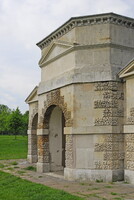| dc.coverage.spatial | Site: London, England, United Kingdom | en_US |
| dc.coverage.temporal | begun 1536 (creation) | en_US |
| dc.creator | Bridgeman, Charles | en_US |
| dc.date | 1536 | en_US |
| dc.date.accessioned | 2013-09-26T15:18:14Z | |
| dc.date.available | 2013-09-26T15:18:14Z | |
| dc.date.issued | 1536 | en_US |
| dc.identifier | 236021 | en_US |
| dc.identifier.other | archrefid: 2607 | en_US |
| dc.identifier.uri | http://hdl.handle.net/1721.3/143756 | |
| dc.description | Detail, Queen's Temple, or Temple Lodge (ca. 1733), raking view of center section; Largest park area in central London and two of the Royal Parks of London. The park is divided in two by the Serpentine; the western half is Kensington Gardens. The two parks are contiguous; although often still assumed to be part of Hyde Park, Kensington Gardens has been technically separate since 1728, when Queen Caroline made a division between the two. The combined area of 630 acres is larger than the Principality of Monaco (480 acres), though smaller than New York City's Central Park (840 acres). The park was the site of the Great Exhibition of 1851, for which the Crystal Palace was designed by Joseph Paxton. The park started as a royal deer park under Henry VIII in 1536. In 1689 William III laid out a drive on the south side that still exists, known as Rotten Row. The first coherent landscaping was undertaken by Charles Bridgeman for Queen Caroline. It was completed in 1733; the Serpentine (1731) was formed by damming the little Westbourne river. The Serpentine is divided from the Long Water by a bridge designed by George Rennie (1826). Source: Wikipedia; http://en.wikipedia.org/wiki/Main_Page (accessed 7/17/2012) | en_US |
| dc.format.medium | stone; brick; paving material; plant material | en_US |
| dc.rights | © Scott Gilchrist, Archivision, Inc. | en_US |
| dc.subject | cityscape | en_US |
| dc.subject | landscape | en_US |
| dc.subject | recreation and games | en_US |
| dc.subject | festivals | en_US |
| dc.subject | City planning | en_US |
| dc.subject | Great Exhibition (1851 : London, England) | en_US |
| dc.subject | parks (recreation areas) | en_US |
| dc.subject | Eighteenth century | en_US |
| dc.title | Hyde Park and Kensington Gardens, London | en_US |
| dc.title.alternative | Hyde Park | en_US |
| dc.type | image | en_US |
| dc.rights.access | Licensed for educational and research use by the MIT community only | en_US |
| dc.identifier.vendorcode | 1A2-E-L-HP-A33 | en_US |
| vra.culturalContext | British | en_US |
| vra.technique | construction (assembling), gardening | en_US |
| vra.worktype | parks (recreation areas) | en_US |
| vra.worktype | garden | en_US |
| dc.contributor.display | Charles Bridgeman (British landscape architect, died 1738) | en_US |


